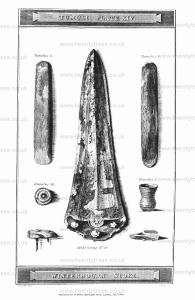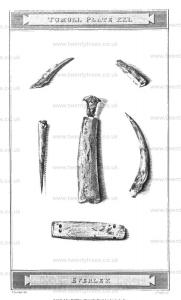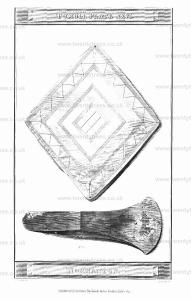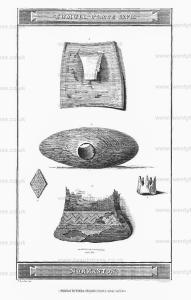Natural History by Pliny the Elder
Natural History by Pliny the Elder is in Roman Books.
Roman Books, Natural History by Pliny the Elder Book 29
Natural History by Pliny the Elder Book 29 Chapter 12
Chapter 12. Serpents' Eggs.
In addition to the above, there is another kind of egg1, held in high renown by the people of the Gallic provinces, but totally omitted by the Greek writers. In summer2 time, numberless snakes become artificially entwined together, and form rings around their bodies with the viscous slime which exudes from their mouths, and with the foam secreted by them: the name given to this substance is "anguinum."3 The Druids tell us, that the serpents eject these eggs into the air by their hissing4, and that a person must be ready to catch them in a cloak, so as not to let them touch the ground; they say also that he must instantly take to flight on horseback, as the serpents will be sure to pursue him, until some intervening river has placed a barrier between them. The test of its genuineness, they say, is its floating against the current of a stream, even though it be set in gold. But, as it is the way with magicians to be dexterous and cunning in casting a veil about their frauds, they pretend that these eggs can only be taken on a certain day of the moon; as though, forsooth, it depended entirely upon the human will to make the moon and the serpents accord as to the moment of this operation.
Note 1. Pliny alludes here to the beads or rings of glass which were used by the Druids as charms to impose on the credulity of their devotees, under the name of Glain naidr, or "the Adder gem." Mr. Luyd (in Rowland's Mona Antiqua, p. 342) says that the genuine Ovum anguinum can be no other than a shell of the kind called echinus marinus, and that Dr. Borlase observes that, instead of the natural anguinum, artificial rings of stone, glass, and sometimes baked clay, were substituted as of equal validity. The belief in these charms very recently existed in Cornwall and Wales, if indeed it does not at the present day. The subject is very fully discussed in Brand's Popular Antiquities, Vol. III. p. 286, et seq., and p. 369, et seq., Bohn's Edition. These gems and beads are not uncommonly found in tumuli of the early British period.
Note 2. A similar belief in its origin was prevalent in Cornwall and Wales, and whoever found it was supposed to ensure success in all his undertakings.
Note 3. "The snake's egg" – ovum being understood.
Note 4. "The vulgar opinion in Cornwall and most parts of Wales is that these are produced through all Cornwall by snakes joining their heads together and hissing, which forms a kind of bubble like a ring about the head of one of them, which the rest, by continual hissing, blow on till it comes off at the tail, when it immediately hardens and resembles a glass ring."— Gough's Camden, Vol. II. p. 571, Ed. 1789.
I myself, however, have seen one of these eggs: it was round, and about as large as an apple of moderate size; the shell5 of it was formed of a cartilaginous substance, and it was surrounded with numerous cupules, as it were, resembling those upon the arms of the polypus: it is held in high estimation among the Druids. The possession of it is marvellously vaunted as ensuring success6 in law-suits, and a favourable reception with princes; a notion which has been so far belied, that a Roman of equestrian rank, a native of the territory of the Vocontii7, who, during a trial, had one of these eggs in his bosom, was slain by the late Emperor Tiberius, and for no other reason, that I know of, but because he was in possession of it. It is this entwining of serpents with one another, and the fruitful results of this unison, that seem to me to have given rise to the usage among foreign nations, of surrounding the caduceus8 with representations of serpents, as so many symbols of peace-it must be remembered, too, that on the caduceus, serpents are never9 represented as having crests.
Note 5. The shell of a sea urchin most probably. See Note 81 above.
Note 6. See Note 82 above.
Note 7. nation of Gaul. See B. iii. cc. 5, 21.
Note 8. The wand held by heralds, and generally represented as being carried by Mercury in his character of messenger of the gods.
Note 9. And therefore not portentous of war.
Colt Hoare 1812. The beads or rings, which are the present object of my attention, are thus noticed by Bishop Gibson, in his improved edition of Camden's Britannia: "In most parts of Wales, and throughout all Scotland, and in Cornwall, we find it a common opinion of the vulgar, that about Midsummer Eve (though in the time they do not all agree) it is usual for snakes to meet in companies, and that by joining heads together, and hissing, a kind of bubble is formed like a ring about the head of one of them, which the rest by continual hissing, blow on till it comes off at the tail: and then it immediately hardens, and resembles a glass ring; which whoever finds, (as some old women and children are persuaded) shall prosper in all his undertakings. The rings which they suppose to be thus generated, are called Gleinneu Nadroedh, i. e, Gemmæ Anguinum, whereof I have seen at several places about twenty or thirty. They are small glass annulets, commonly about half as wide as our finger rings, but much thicker; of a green colour usually, though some of them are blue, and others I have also seen two or three curiously waved with blue, red, and white, earthen rings of this kind, but glazed with blue, and adorned with transverse streaks or furrows on the outside. There seems to be some connection between the GLAIN NEIDYR of the Britons, and the OVUM ANGUINUM mentioned by Pliny, as being held in veneration by the Druids of Gaul; and to the formation of which, he gives nearly the same origin. They were probably worn as an insigne, or mark of distinction, and suspended round the neck, as the perforation is not suffciently large to admit the finger. This bead, which I consider as a very interesting relict of antiquity, is engraved of its original size in TUMULI Plate X IV.

Colt Hoare 1812. No. 158 [Map]. Though Dr. Stukeley has given an engraving of this tumulus, under the title of BUSH BARROW, it does not appear that he ever attempted open it. It was formerly fenced round and planted with trees, and its exterior at present bears a very rough appearance from being covered with furze and heath. The first attempts made by Mr. Cunnington on this barrow proved unsuccessful, as also those of some farmers, who tried their skill in digging into it. Our researches were renewed ill September, 1808, and we were amply repaid for our perseverance and former disappointment. On reaching the floor of the barrow, we discovered the skeleton of a stout and tall man lying from south to north: the extreme length of his thigh bone was 20 inches. About 18 inches south of the head, we found several brass rivets intermixed with wood, and some thin bits of brass nearly decomposed. These articles covered a space of 12 inches or more; it is probable, therefore, that they were the mouldered remains of a shield. Near the shoulders lay the fine celt1 Tumuli Plate XXVI. No. 1, the lower end of which owes its great preservation to having been originally inserted in within a handle of wood. Near the right arm was a large dagger of brass, and a spear-head of the same metal, full thirteen inches long, and the largest we have ever found, though not so neat in its pattern as some others of an inferior size which have been engraved in our work. These were accompanied by a curious article of gold, which conceive had originally decorated the case of the dagger, Tumuli Plate XXVII, No. 1. The handle of wood belonging to this instrument, No. 2, exceeds any thing we have yet seen, both in design and execution, and could not he surpassed (if indeed equalled) by the most able workman of modern times. By the annexed engraving, you will immediately recognize the British zigzag, or the modern Vandyke pattern, which was formed with a labour and exactness almost unaccountable, by thousands of gold rivets, smaller than the smallest pin. The head of the handle, though exhibiting no variety of pattern, was also formed by the same kind of studding. So very minute, indeed, were these pins, that our labourers had thrown out thousands of them with their shovel, and scattered chem in every direction, before, by the necessary aid of a magnifying glass, we could discover what they were; but fortunately enough remained attached to the wood to enable us to develop the pattern. Beneath the fingers of the right hand lay a lance-head of brass, but so much corroded that it broke to pieces on moving. Immediately over the breast of the skeleton was a large plate of gold, Tumuli Plate XXVI. in the form of a lozenge, and measuring 7 inches by 6. It was fixed to a thin piece of wood, over the edges of which the gold was lapped: it is perforated at top and bottom, for the purpose, probably, of fastening it to the dress as a breast-plate. The even surface af this noble ornament is relieved by indented lines, checques, and zigzags, following the shape of the, outline, and forming lozenge within lozenge, diminishing gradually towards the centre. We next discovered, on the right side of the skeleton, a very curious perforated stone, some wrought articles of bone, many small rings of the same material, and another article of gold Plate XXVII, No 3, 4, 5. The stone is made out of a fossil mass of tubularia, and polished; rather of an egg form, or as a farmer who was present, observed, resembling the top of a large gimlet. It had a wooden handle, which was fixed into the perforation in the centre, and encircled by a neat ornament of brass, part of which still adheres to the stone. As this stone bears no marks of wear or attrition, I can hardly consider it to have been used as a domestic implement, and from the circumstance of its being composed of a mass of seaworms, or little serpents, I think we may not be too fanciful in considering it an article of consequence. We know, by history, that much importance was attached by the ancients to the serpent, and I have before had occasion to mention the veneration with which the glain nadrogth. was esteemed by the Britons; and my classical readers will recollect the fanciful story related by Pliny on this subject, who says, that the Druid's egg was formed by the scum of a vast multitude of serpents twisted and conjured up together. This stone, therefore, which contains a mass of or little serpents, might have been held in great veneration by the Britons, and considered of sufficient importance to merit a place amongst the many rich and valuable relicks deposited in this tumulus with the body of the deceased.
1. The word CELT has been applied to instruments of a very different form as well as composition, and has been written, engraved, and published concerning them. In the fifth volume of the Archæologia, we find a dissertation on them by Mr. Lort. accompanied by numerous engravings describing their different forms, some few of which resemble those that we have discovered; but one only is recorded a having been found in a Long barrow near Stonehenge by Dr. Stukeley, and rot recorded as a certainty. Much conjecture and debate have been employed by various authors respecting the original use of this instrument. Mr. Thoresby, in a letter to the celebrated antiquary Thomas Hearne, supposes them to have been heads of spears: or walking staves of the civilized Britons; but this opinion is rejected by Hearne, who thinks they were chissels used b the Romans for cutting and polishing stones. A curious inscription at Pola, in Istria, ascertains hat the word celtis denoted a chissel or graving tool, "Neque hic atramentum, vel papyrus, aut membrana ulla adhuc, sed malleolo et celie literatus silex, [Cruterus page 329]. Dr. Borlase also, in his Antiquities of Cornwall, page 281, has given an account of several brass Celts found in that county, together with an engraving. He supposes them to have been offensive weapons, and to have been made and used by the Romanized Britons. Dr. Stukeley attaches a degree of religious authority to them, by supposing that they were used by the Druids for cutting the mistletoe. These instruments differed in their construction, and in point of antiquity, l must give the priority of age to those discovered in our barrows, of which I am enabled to produce four specimens. The first engraved ia Tumuli Plate XXI is highly interesting, and shews the mode which the brass instrument was inserted in the handle. The second, engraved in Plate XXVI. is of a much larger size, but also had its handle; as well as two others engraved in subsequent plates, which, though smaller, resemble the others in form. I am obliged, from conviction, and from the strong evidence afforded by this handle, to differ from the learned antiquaries who have delivered their opinions on this subject. I cannot, with Mr. Thoresby and Dr. Borlase. suppose them to have been spear-heads, or offensive weapons; neither can I agree with the laborious antiquary, Thomas Hearne, in supposing them edge-tools for cutting stones, the metals of which they are formed are soft for such a purpose; neither can we find the edges furrowed and scratched by hard usage; nor can my antiquarian zeal and enthusiasm persuade me to coincide, in this instance, with the Druidical system of Dr, Stukeley. They appear to me to have been instruments used for domestic, not for mihitary, architectural, or purposes. These appear also to have been the first models, from which the pattern with sockets for the insertion of a handle was taken; for amongst the numerous specimens described by Mr. Lort in the Archæologia, not one of the latter pattern is mentioned as having been discovered in a barrow. As many similar instruments have been found in Gaul, and have been noticed by and Caylus, I cannot attribute the sole manufacture of them to Britain, but rather suppose they imported thither from the mother country on the continent; or perhaps the art of making them might have been introduced. One circumstance, I think, appears evident and conclusive viz. that the earliest pattern, and which probably gave rise to the larger and more ornamented one, was that described in four instances as having been discovered amongst other sepulchral deposits in British tumuli. The celts of flint, engraved in Tumuli PlateS V, VI. were evidently used for chipping stone or other materials, of which I can adduce a curious proof, by the circumstances attending discovery of one of these articles, which is now in my possession. Some workmen in cutting a canal, near Stockbridge, found several of these flint Celts dispersed about the soil, and deposited near the rude trunk af a tree, which was intended to have been fashioned by their means into a boat or canoe.


